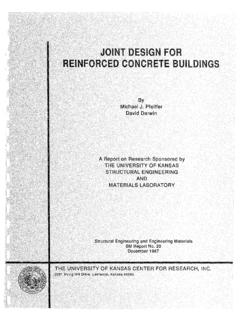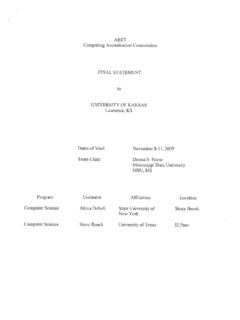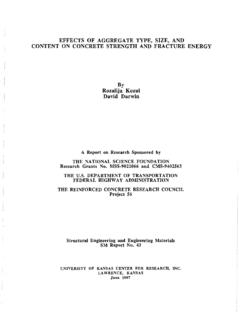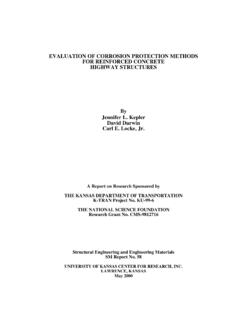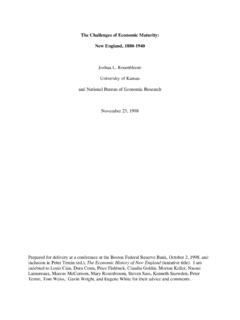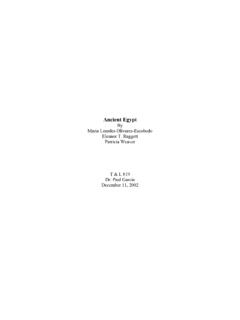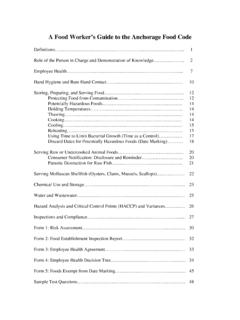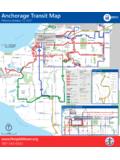Transcription of ANCHORAGE OF HIGH-STRENGTH REINFORCING …
1 ANCHORAGE OF HIGH-STRENGTH REINFORCING BARS WITH STANDARD HOOKS: INITIAL TESTS By Jeff Peckover David Darwin A Report on Research Sponsored by Electric Power Research Institute Concrete Steel REINFORCING Institute Education and Research Foundation University of Kansas Transportation Research Institute Charles Pankow Foundation Commercial Metals Company Gerdau Corporation Nucor Corporation MMFX Technologies Corporation Structural Engineering and Engineering Materials SL Report 13-1 THE UNIVERSITY OF KANSAS CENTER FOR RESEARCH, INC. LAWRENCE, KANSAS January 2013 ii Abstract This report describes the initial tests on the ANCHORAGE strength of standard hooked bars in concrete.
2 The goal of the testing is to determine the effects embedment length, side cover, tail cover, quantity of transverse reinforcement, location of longitudinal reinforcement, concrete strength , bar size, and bar bend on the ANCHORAGE strength of hooked bars in concrete. Initial tests have been performed on No. 5 and No. 8 bars, with 90 and 180 hooks, cast in concrete with a nominal compressive strength of 5000 psi. Further testing will also include No. 11 bars and concrete strengths up to 15,000 psi. The goal of this study is to gain a firm understanding of the ANCHORAGE strength of hooked bars in concrete as a function of the key variables and use the data to establish reliability-based design expressions for development length.
3 Thus far, the testing apparatus has been fabricated, the testing procedures have been established, and the initial specimens have been tested. The test results agree qualitatively with those in previous studies and show that hook strength increases with increased embedment length, side cover, and confining reinforcement. The results also show that hook strength is greater for hooks anchored within a column core than for hooks anchored outside of the core. The latter case is appropriate to hooks anchoring bars at the end of cantilever beams.
4 Keywords: ANCHORAGE , development, hooks, reinforced concrete i Acknowledgements This report is based on research performed by Jeff Peckover in partial fulfillment of the requirements for the MSCE degree from the University of Kansas. Support for the study was provided by the Electric Power Research Institute, Concrete REINFORCING Steel Institute Education and Research Foundation, University of Kansas Transportation Research Institute, Charles Pankow Foundation, Commercial Metals Company, Gerdau Corporation, Nucor Corporation, and MMFX Technologies Corporation.
5 Additional materials were supplied by Dayton Superior and Midwest Concrete Materials. ii TABLE OF CONTENTS Page Chapter 1: Introduction .. 1 : Objective .. 1 : Definition of the Problem .. 1 Chapter 2: Experimental Work .. 3 : Specimens .. 3 : Specimen Design .. 3 : Casting Specimens .. 9 : Material Properties .. 11 : Loading Systems .. 12 Testing Apparatus .. 12 : Hooked Bar Grips .. 15 : Super Washers .. 18 : Instrumentation .. 19 : Load Cells .. 19 : External Slip Measurement .. 22 : Internal Slip Measurement.
6 24 : Testing 27 Chapter 3: Evaluation of Test Results .. 35 : Test Results .. 35 : Crack Patterns .. 39 : Failure 40 : Data Trends .. 42 Chapter 4: Summary .. 46 References .. 47 iii List of Figures Page Figure 1: Top view of hook region for No. 5 bars placed inside longitudinal reinforcement 4 Figure 2: Top view of hook region for No. 5 bars placed outside longitudinal 5 Figure 3: Side view of a specimen with No. 5 hooks .. 6 Figure 4: Shear reinforcement placed inside of hooks.
7 7 Figure 5: Typical joint regions in specimens .. 8 Figure 6: Front and back view of forms .. 9 Figure 7: Assembled forms with hooks 10 Figure 8: Testing apparatus .. 12 Figure 9: Test frame: (a) Back view; (b) Front view .. 13 Figure 10: Forces on test 14 Figure 11: Hooked bars extending through the jacks with load cells supported by 16 Figure 12: Close up of hook extensions .. 17 Figure 13: Nuts tightened onto the threaded bars of the hook extensions .. 17 Figure 14: Super washers .. 18 Figure 15: Threaded bar attached to super washer .. 19 Figure 16: Load cells placed on hooked bars.
8 20 Figure 17: Load cells measuring axial compression .. 21 Figure 18: Covered LVDTs fixed to the apparatus .. 22 Figure 19: Close up of steel extension .. 23 Figure 20: Wire for internal slip measurement attached to hook .. 25 Figure 21: Wire protruding from specimen and attached to string pot .. 26 Figure 22: Frame holding string pot .. 26 Figure 23: Hydraulic jacks affixed to the testing apparatus .. 27 iv Figure 24: Bottom cross beam placed below the base plate .. 28 Figure 25: Weather stripping on the specimen .. 29 Figure 26: Placing Hydro-Stone between specimen and apparatus.
9 30 Figure 27: Channel sections tightened to the specimen .. 31 Figure 28: Threaded bar with proper length placed on specimen .. 32 Figure 29: (a) Placing top cross beam with crane; (b) Bottom load cells in place .. 33 Figure 30: Cracks propagating from the hooked bars .. 39 Figure 31: Vertical cracks forming a conical shape .. 40 Figure 32: Breakout 41 Figure 33: Side splitting failure .. 41 Figure 34: Side blowout failure .. 42 Figure 35: Ultimate bar stress versus embedment length for 90 No. 5 hooked bars with no transverse 43 Figure 36: Ultimate bar stress versus embedment length for 90 No.
10 5 hooked bars with 5 No. 3 bars transverse reinforcement .. 44 Figure 37: Ultimate bar stress for No. 8 bar 90 hooks with nominal embedment length and nominal side cover .. 45 v List of Tables Page Table 1 - Example group of specimens .. 5 Table 2- Concrete mixture proportions .. 11 Table 3- Hooked bar 11 Table 4 - Specimen properties and test results .. 37 Table 4 Continued Specimen properties and test results .. 38 vi Chapter 1: Introduction : Objective This report describes ongoing research on the ANCHORAGE strength of bars with standard hooks in concrete.
